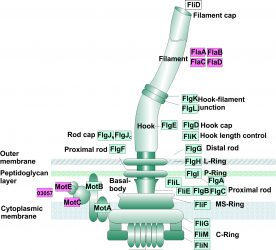
The clockwise-rotating rhizobial flagellar motor
The bacterial flagellum is a complex self-assembling macromolecular machine that requires more than 50 proteins for formation, regulation, and function. As an adaptation to the viscous soil environment, Sinorhizobium meliloti and other plant-interacting rhizobial soil bacteria developed a unique flagellar motor. One major difference between the S. meliloti and the enterobacterial system is the presence of four flagellin subunits (Fla A-D), which form complex, more rigid filaments, which makes it more efficient in the viscous milieu of the soil. We have also shown that directional changes of a swimming cell are caused by the uni-directional clockwise (cw) rotation of several flagella at different speeds. Uni-directional rotation of the flagellar motor, paired with speed variation, required the evolution of additional proteins. This research aims towards an understanding of the role of unique motor proteins in rhizobial motility.
References:
R.C. Sobe & Scharf B.E. (2024) “The swimming defect caused by absence of the transcriptional regulator LdtR in Sinorhizobium meliloti is restored by mutations in the motility genes motA and motS” Molecular Microbiology; 121(5):954-970.
M.A.B. Kreutzberger, Sonani R.R., Liu J., Chatterjee S., Wang F., Sebastian A.L., Biswas P., Ewing C., Zheng W., Poly F., Frankel G., Luisi B.F., Calladine C.R., Krupovic M., Scharf B.E., Egelman E.H. (2022) Convergent evolution in the supercoiling of prokaryotic flagellar filaments. Cell 15;185(19):3487-3500.
R.C. Sobe, Gilbert C., Vo L., Alexandre G., Scharf B.E. (2022) FliL and its paralog MotF have distinct roles in the stator activity of the Sinorhizobium meliloti flagellar motor. Molecular Microbiology 118(3), 223-243.
M.A.B. Kreutzberger, Sobe R., Sauder A.B., Chatterjee S., Pena A., Wang F., Giron J.A., Kiessling V., Costa T.R.D., Conticello V.P., Frankel G., Kendall M.M., Scharf B.E.* Egelman E.H.* (2022) Dimerization and tetramerization of flagellin outer domains modulate polymorphism and motility in pathogenic E. coli and soil bacteria. Nature Communications, 7;13(1):1422. *Co-corresponding authors.
C. Rotter, Mühlbauer S., Schmitt R., Scharf B. (2006) Rem, a new transcriptional regulator of the flagellar regulon in Sinorhizobium meliloti. Journal of Bacteriology 188, 6932-6942. (DOI:10.1128/JB.01902-05)
E. Eggenhofer, Rachel R., Haslbeck M., and Scharf B. (2006) MotD of Sinorhizobium meliloti and related a-proteobacteria is the flagellar hook-length regulator and therefore re-assigned as FliK. Journal of Bacteriology 188, 2144-2153. (DOI:10.1128/JB.188.6.2144-2153.2006 )
U. Attmannspacher, Scharf B., Schmitt R. (2005) Control of speed modulation (chemokinesis) in the unidirectional rotary motor of Sinorhizobium meliloti. Molecular Microbiology 56, 708-718. (DOI:10.1111/j.1365-2958.2005.04565.x)
E. Eggenhofer, Haslbeck M., Scharf B. (2004) The novel protein MotE serves as chaperone for the periplasmic motor protein MotC in Sinorhizobium meliloti. Molecular Microbiology 52, 701-712. (DOI:10.1111/j.1365-2958.2004.04022.x)
B. Scharf (2002) Real-time imaging of fluorescent flagellar filaments of Rhizobium lupini H13-3: Flagellar rotation and pH-induced polymorphic transitions. Journal of Bacteriology 184, 5979-5986. (PMCID:PMC135403)
B. Scharf, Schuster-Wolff-Bühring H., Rachel R., Schmitt R. (2001) Mutational analysis of the Rhizobium lupini H13-3 and Sinorhizobium meliloti flagellin genes: Importance of flagellin A for flagellar filament structure and transcriptional regulation. Journal of Bacteriology 183, 5334-5342.v (PMCID:PMC95416)

